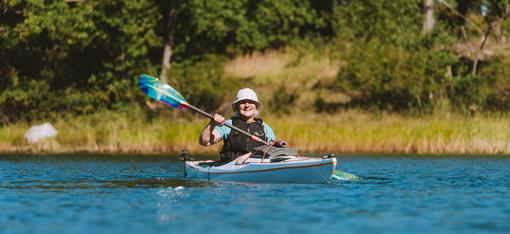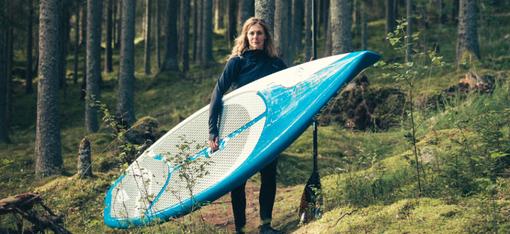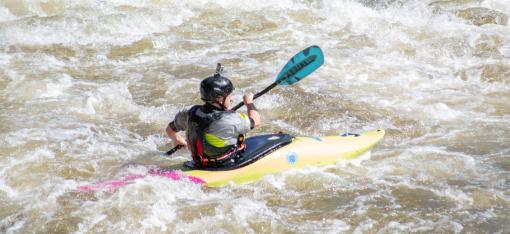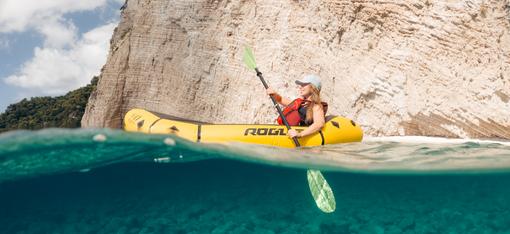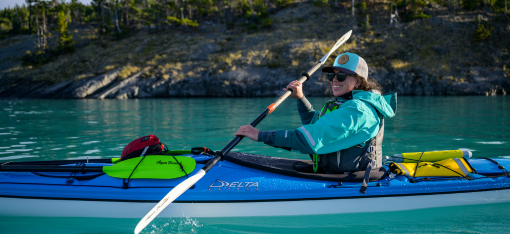Use GoPro to Film Your Own Kayaking Adventures

(photo courtesy of @tfbergen)
Expert kayaker and Aqua Bound ProStaffer, Ken Whiting, shares his tips and strategies for filming your own kayaking adventures with a GoPro action camera in this video.
Whether you have your own YouTube channel, film for your paddle company’s marketing efforts, or simply want to share your adventures with friends, filming your paddle trips captures the moments and memories so you can relive them later.
Watch the video below for Ken’s best tips on filming your own kayaking adventures:
How to Choose the Right Camera
You have a couple different options to choose from when it comes to a camera. First, is to use your phone’s camera. Cameras built-in to today’s cell phones are often high quality—plenty for your filming needs. However, the downside of using your phone for outdoor adventure filming is that if you lose it, you haven’t just lost your camera, but also a ton of data and other important information.
That’s why Ken doesn’t use his phone to film—they’re more expensive than even the best action cameras. He doesn’t want his ending up in the bottom of a river or lake.
One of Ken’s Rules of Filming on the Water: You will lose your camera to the water at some point!
Ken prefers GoPro to any other action camera on the market, and there are many. “They’re the pioneers and they keep pushing the boundaries of what you can do with such a small camera.”
Which GoPro should you choose? Here are some keys to look for for filming kayak trips:
- Waterproof—A no-brainer for paddle adventures. The newer GoPros are all fully waterproof with no need for a waterproof container.
- Image Stabilization—Keeps the image stable as you film. This is also key since your kayak won’t be still, ever, when you’re on the water.
- Voice Activation—No need to keep your camera within arm’s length.
- Framing—The newest GoPros have a screen on the camera’s front to make framing easy when you’re filming yourself.
- Slow Motion—Easy to overuse! But it’s a great feature to have.
- Hindsight—The newest GoPros have a hindsight setting to give you the 30 seconds prior to the actual recording.

(photo courtesy of @pete.lavigne)
How and Where to Mount Your Camera
Companies even beyond the camera makers like GoPro have come up with a myriad of solutions for mounting action cameras. Here are the main types of mounts:
- Sticky GoPro Mount—This little mounting system sticks to any smooth, clean surface. Great if you like your camera in the same couple of spots all the time.
- Suction Cup Mount—Ken hasn’t found this type of mount to be as secure. If you use one, definitely tie it on as a backup in case the suction fails.
- Clip Mount—Moveable and versatile mount that you can use in different boats and locations.
- Mount to you instead of your boat—Ken likes the Chest Mount the best for filming paddling adventures. Not only does it capture the action well, but it’s in the perfect spot to record your voice if you’ll narrate along.
- Camera Mount Accessories—There are several mounts available that you can attach to your kayak’s gear tracks. These give you a ton of options for camera angles. Just be sure your camera’s location doesn’t interfere with your paddling strokes. These different accessories provide you with almost limitless filming options.
- Tripod for on-shore filming—Sometimes you’ll want a different perspective. A tripod makes that possible, combined with your voice activated action camera.

(photo courtesy of @dadonovan)
Camera Settings
If you plan to use solid video edited software, go ahead and film in 4K. The files are huge so you’ll need a computer able to handle those large files. If you shoot in 2.7K you can still do a fair bit of edited but without those huge file sizes.
The frame rate, the frames per second setting, can vary. 24 or 30 FPS are both common, although Ken has found he likes filming at 60 FPS. That way he has the option of slowing it down for a slow motion feel and it still gives him great sound and images.
Perspective is another consideration when filming. Ken tends to use linear or wide perspective for most of his filming. You can experiment to see what the different perspectives look like on film, depending on where the camera is mounted and what result you’re after.
How much or little post-production work you put into your filming is really up to you, your goals and uses for your films.
Audio Considerations
If you decide you want to capture audio with your films, there are a couple considerations. The biggest difference between amateur videos and high-quality videos is the audio quality.
The newer and better GoPros have a small external mic and, better, the option to plug in an external receiver that works with a mic you can clip on yourself. This really helps cut out wind and other noises you don’t want in your video. It also helps give you the best sound quality if your action camera is mounted behind you.

(photo courtesy of @paulvillecourt)
How much you spend and how much effort you put into filming your kayaking adventures is personal. It depends on your budget, your interest and time, and your goals for filming.
Capturing high-quality action, though, has never been more affordable for the average filmmaker!
Do you have paddle questions our friendly Customer Service Team can help you with today? Content them: 715-755-3405 • sales@aquabound.com
More for you...

